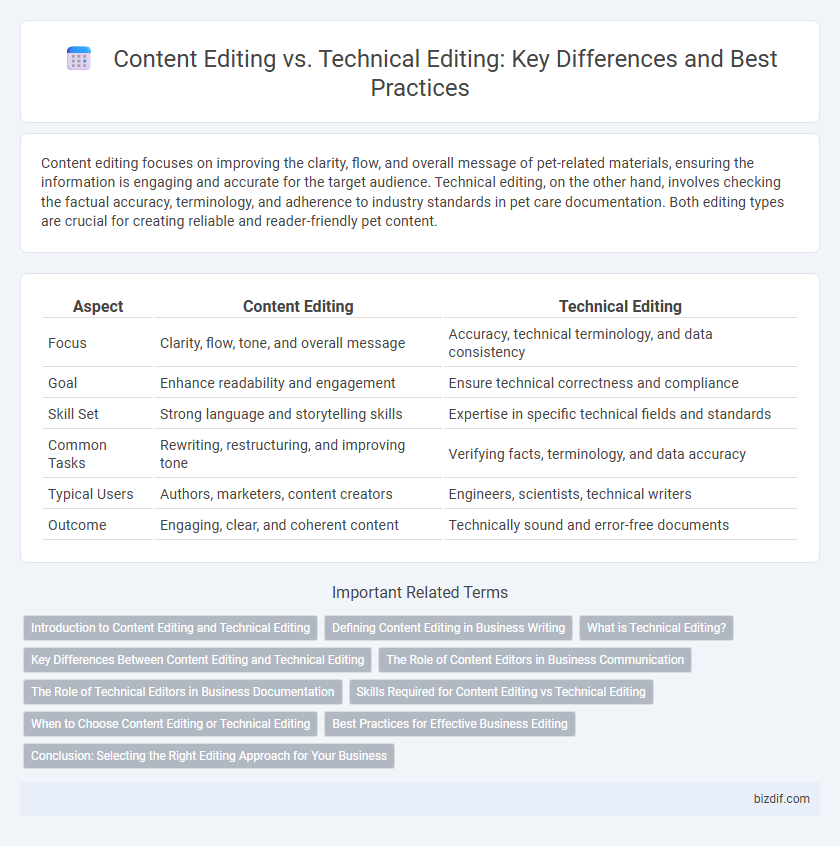Content editing focuses on improving the clarity, flow, and overall message of pet-related materials, ensuring the information is engaging and accurate for the target audience. Technical editing, on the other hand, involves checking the factual accuracy, terminology, and adherence to industry standards in pet care documentation. Both editing types are crucial for creating reliable and reader-friendly pet content.
Table of Comparison
| Aspect | Content Editing | Technical Editing |
|---|---|---|
| Focus | Clarity, flow, tone, and overall message | Accuracy, technical terminology, and data consistency |
| Goal | Enhance readability and engagement | Ensure technical correctness and compliance |
| Skill Set | Strong language and storytelling skills | Expertise in specific technical fields and standards |
| Common Tasks | Rewriting, restructuring, and improving tone | Verifying facts, terminology, and data accuracy |
| Typical Users | Authors, marketers, content creators | Engineers, scientists, technical writers |
| Outcome | Engaging, clear, and coherent content | Technically sound and error-free documents |
Introduction to Content Editing and Technical Editing
Content editing focuses on improving the clarity, flow, and engagement of the text by refining language, structure, and tone to suit the target audience and purpose. Technical editing involves verifying factual accuracy, consistency, and adherence to specific industry standards or guidelines, often requiring subject matter expertise. Both editing types ensure polished and effective communication but target different aspects of the document's quality and precision.
Defining Content Editing in Business Writing
Content editing in business writing focuses on improving clarity, coherence, and overall message effectiveness by refining structure, tone, and flow. It ensures the content aligns with the intended audience's needs and business objectives, enhancing readability and engagement. This process differs from technical editing, which primarily addresses accuracy and correctness of technical information and jargon.
What is Technical Editing?
Technical editing involves reviewing and refining documents to ensure accuracy, clarity, and consistency, particularly in specialized fields such as engineering, IT, and science. It focuses on verifying technical facts, correcting terminology, and improving the document's structure to enhance readability for the target audience. Unlike content editing, which emphasizes narrative flow and style, technical editing prioritizes precision and adherence to industry standards.
Key Differences Between Content Editing and Technical Editing
Content editing focuses on enhancing the clarity, flow, and overall narrative of a document to improve readability and engagement, ensuring the message aligns with the target audience's needs. Technical editing emphasizes accuracy, consistency, and adherence to specific industry standards or technical specifications, verifying facts, terminology, and data precision. Key differences include content editing's goal of storytelling and audience engagement versus technical editing's focus on correctness and compliance with technical requirements.
The Role of Content Editors in Business Communication
Content editors in business communication ensure clarity, coherence, and persuasive messaging by refining the tone, style, and structure to resonate with target audiences. Their role involves aligning content with brand voice and strategic goals, enhancing readability and engagement without altering the technical accuracy of the information. Unlike technical editors who focus on factual correctness and precision, content editors prioritize effective storytelling and audience connection to drive business outcomes.
The Role of Technical Editors in Business Documentation
Technical editors ensure business documentation is accurate, clear, and aligned with industry standards by focusing on specialized content such as manuals, reports, and compliance materials. They verify technical details, improve readability for target audiences, and maintain consistency in terminology and formatting to enhance document usability. Their expertise bridges the gap between complex data and user-friendly communication, crucial for effective business operations and decision-making.
Skills Required for Content Editing vs Technical Editing
Content editing requires strong skills in narrative structure, clarity, tone consistency, and audience engagement to ensure the message resonates effectively with readers. Technical editing demands expertise in subject matter, precise terminology, formatting standards, and accuracy to maintain the integrity of specialized information. Both roles necessitate attention to detail and proficiency in language mechanics, but content editing centers on storytelling elements while technical editing emphasizes factual correctness and technical precision.
When to Choose Content Editing or Technical Editing
Choose content editing when the goal is to enhance clarity, narrative flow, and overall readability, ensuring the message resonates with the target audience. Opt for technical editing when accuracy, consistency, and adherence to industry-specific standards or guidelines are critical, particularly in scientific, legal, or technical documents. Assess the project's primary needs--whether improving engagement or ensuring technical precision--to determine the most suitable editing approach.
Best Practices for Effective Business Editing
Effective business editing requires distinguishing between content editing and technical editing to enhance clarity and accuracy. Content editing focuses on refining the message, tone, and structure to ensure the text aligns with business goals and audience needs, while technical editing ensures correctness in terminology, data accuracy, and compliance with industry standards. Implementing thorough peer reviews, using style guides such as the Chicago Manual of Style or APA, and maintaining consistency in voice and format optimize the impact of business documents.
Conclusion: Selecting the Right Editing Approach for Your Business
Choosing the appropriate editing approach depends on your business goals, target audience, and the complexity of your content. Content editing enhances clarity, tone, and engagement to resonate with readers, while technical editing ensures accuracy, consistency, and adherence to industry standards in specialized fields. Aligning your editing strategy with your business needs maximizes communication effectiveness and brand credibility.
Content Editing vs Technical Editing Infographic

 bizdif.com
bizdif.com